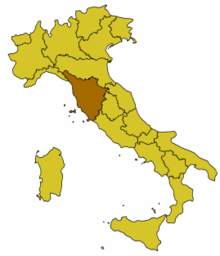Tuscany (incl. Toscana) - central administrative region Italy with the capital we FlorenceIt is situated on the Tyrrhenian Sea, on the west coast of the Apennine Peninsula.
It is the most visited region of Italy (maybe outside Rome) and the most popular destination for tourists from all over the world. Tuscany has many advantages, the most important of which are: priceless Renaissance art (Florence), delicious Tuscan cuisine and wines, as well as beautiful nature, landscapes and the sea.
General information

Tuscany is a land of stone houses, soaring cypresses and olive groves. However, for someone who has been seduced by its charm, it is much more. Tuscany is above all a feast of smells and flavors unparalleled anywhere else in the world. On hot days (in summer the temperature reaches even 45 degrees Celsius), the air is filled with the captivating scent of ripe tomatoes, basil, tasty truffles and an indescribable scent of ripening olives warmed by the southern sun. The taste and aroma of the morning espresso will remain in the memory of the coffee gourmand for a long time, and the juicy "bistecca alla fiorentina" (beef steak) will satisfy the culinary expectations of the most demanding palates. Tuscany is a small stone town where life goes on at a slow pace. From a lazy morning, when the locals meet in a small cafeteria for a morning espresso, through a siesta lasting almost half a day (when all bars and shops are closed), to an evening that brings a slight liveliness and lasts until late at night. This is the time when many Italian families spend long time in local tratories eating pasta or pizza and drinking delicious Italian wine. After all, Tuscany is a land of wine. Numerous vineyards hidden among the green hills are a treasure trove of flavors for both the beginner gourmand and the connoisseur of this drink.

Tuscany has 3 faces: large (Florence, Siena, Pisa) and smaller historical cities (Arezzo, Lucca, Grosetto), rural regions and the coastal region (including islands). above
Regions
Tuscany is divided into 10 provinces:
- Arezzo (AR)
- Florence (FI)
- Grosseto (GR)
- Livorno (LI)
- Lucca (LU)
- Massa-Carrara (MS)
- Pisa (PI)
- Pistoia (PT)
- Prato (AFTER)
- Siena (SI)
In addition, there are geographical and historical regions:
- Casentino - forested mountain valleys of the river Arno and headwaters to Arezzo
- Chianti - a wine region in the heart of Tuscany
- Colline Metallifere - geysers, geothermal energy and beautiful nature south-west of Siena
- Crete senesi - rocky hills and a quiet region south of Siena
- Etruscan Riviera - coast between Livorno and Piombino popular with tourists
- Garfagnan - in the Apuan Alps north of Lucca
- Lunigiana - coast and mountains on the border with Liguria
- Maremma - the little-known southwestern part of Tuscany
- Montagnola senese - a green paradise near Siena
- Monte Amiata - a mountain in southern Tuscany
- Mugello - garden landscape north of Florence
- Valdarno (Arno Valley) - agriculture and tourism in harmonious coexistence
- Val d'Elsa (Elsa Valley) - crystals and handicrafts in the central part of Tuscany
- Val di Chiana (Chiana Valley) - the valley of the Chiana River, flowing into the Tiber
- Val d'Orcia (Orcia Valley) - hot springs, hills and cypresses
- Versilia - the coast in northern Tuscany
- Tuscan Islandswhich also include the island Elba
Cities

More interesting cities in Tuscany (in alphabetical order):
- Anghiari (AR)
- Arezzo - centuries of history, chic boutiques and works of art have driven the crowds of tourists away
- Swamp of Vignoni (SI) - Peaceful health resort with impressive pools
- Bibbie (AR) - among the forests of Casentino
- Bibbon (LI) - sea resort
- Carrara (MS) - the city of white marble
- Camaiore (LU) - a bustling seaside resort, often chosen for holidays
- Castiglione d'Orcia (SI) - a town with a picturesque agricultural landscape in the background
- Chiusi (SI) - monuments from Etruscan times
- Colle di Val d'Elsa (SI) - a city on two levels
- Cortona (AR) - a charming provincial town with Etruscan roots
- Florence - during the Renaissance, one of the most important and richest cities in Europe
- Greve in Chianti (FI) - the capital of Chianti Classico and the homeland Gallo Nero
- Grosseto - the bustling capital of Maremma with a charming old town
- Livorno - modern Tuscan life, industry and an important port
- Lucca - the entire Old Town surrounded by walls from the 16th and 17th centuries
- Montalcino (SI) - Honey and wine flowing
- Montecatini Terme (PT) - famous thermal waters
- Montepulciano (SI) - a city of wine named Vino Nobile
- Pienza (SI) - the pearl of the Renaissance
- Pisa (PI) - an important port in the Middle Ages, now a city focused on tourists
- Pitigliano, Sovana and Sorano (GR) - cities made of tuff, with an ancient Etruscan past
- Pistoia - the forgotten "neighbor" of Florence
- Poppi (AR) - a medieval town among forests
- Prato -
- Radda in Chianti (FI) - love of wine
- San Gimignano (SI) -
- San Quirico d'Orcia (SI) - cypresses in a mountainous area
- Santa Fiora (GR) - with sources of mineral water
- Siena - a beautiful "competitor" of Florence
- Volterra (PI) - alabaster
- Viareggio (LU) - a fashionable seaside resort in the Art Nouveau style

